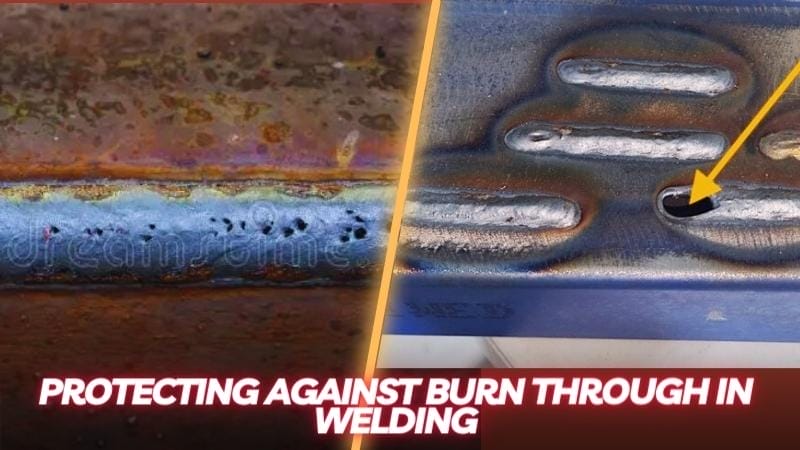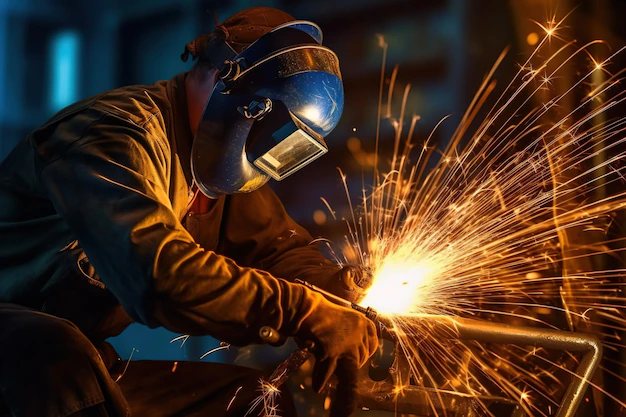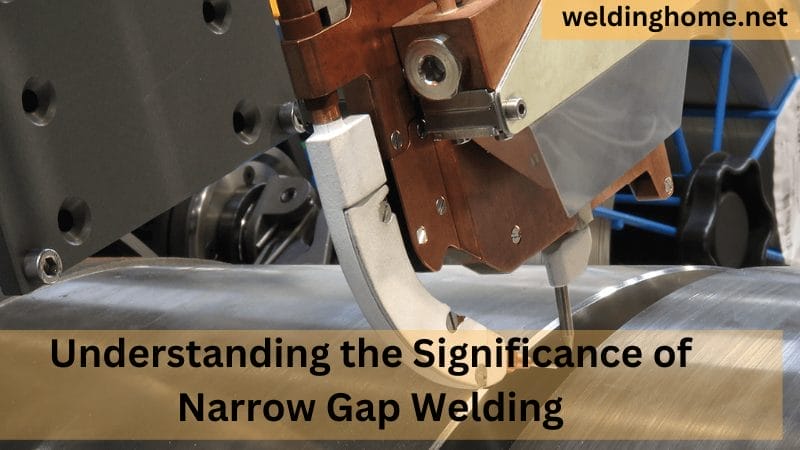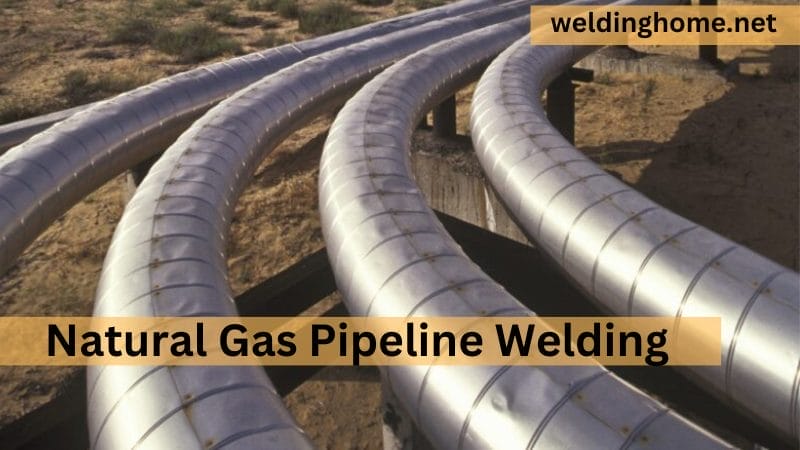Protecting Against Burn Through in Welding: What Causes It and How to Stop It

Construction, automotive, and other sectors rely on welding. However, “Protecting Against Burn Through in Welding,” a common issue for welders, may affect weld quality and integrity. This detailed welding article will explain burn-through and its causes.
Burn-through, or “blow-through,” is a welding fault penetrating the base material. Too much heat during welding melts the metal, producing a hole in the workpiece. Burn-through is prevalent in welding and may weaken the welded connection, threatening safety and project integrity.
I will examine burn-through causes and, most importantly, preventative methods to help welders overcome this difficulty. Welders may guarantee their work is durable, dependable, safe, and high-quality by understanding and minimizing burn-through.
What is Protecting Against Burn Through in Welding?
The base material’s penetration or “burning through” Protecting Against Burn Through in Welding is frequent and undesired. When welding heat or current is too high, the base metal melts, sometimes creating a hole.
This may weaken welds, cause structural faults, and threaten project integrity. Burn Through in Welding occurs when heat is used beyond what is needed for an effective weld, causing material penetration and weakening the joint.
Welders worry about Burn Through in Welding because it lowers quality and dependability. Welders wanting to make substantial, lasting, safe, high-quality welds must understand burn-through causes and prevention.
What Causes Burn-Through in Welding

Insufficient Welding Amperage:
Often, -Burn Through in Welding occurs due to insufficient welding current, which fails to provide the necessary heat for a strong fusion. In an attempt to compensate for this shortfall, some welders may increase their travel speed or apply additional passes, inadvertently raising the risk of burn-through due to insufficient heat input.
Excessive Amperage in Welding:
Conversely, excessive welding current generates an abundance of heat, causing the base material to melt excessively. This can escalate the likelihood of burn-through, especially when working with thinner materials.
Reduced welding travel rate:
The speed at which the electrode is moved plays a crucial role in controlling heat input. A slow-moving electrode increases the time spent on the weld pass, leading to greater heat input. This extended exposure to heat can lead to over-melting and a higher susceptibility to burn-through.
Inadequate preparation of the weld joint:
Burn-through in Welding is frequently a consequence of poor joint preparation. Even with the correct welding parameters and techniques, neglecting tasks before initiating the welding process can lead to issues. Excessive grinding and inadequate cleaning can lower the quality of joint preparation.
Excessive base metal grinding
Before welding, base metal edges are often beveled to allow for proper filler material integration. This beveling process is typically achieved through grinding. However, it’s essential to exercise care during this grinding process, as excessive grinding can create deeper bevels than necessary. These excessively deep bevels make the joint more susceptible to melt-through.
Inadequate preparation of base metal Metal
“Protecting Against Burn Through in Welding: ” Learn why proper base metal cleaning is essential for avoiding burn-through problems in welding, Effective base metal cleaning is essential before initiating welding. Many metals, such as galvanized steel or aluminum, possess protective layers that become highly reactive at elevated temperatures. For instance, aluminum oxide is a thin film present on every piece of aluminum. While it safeguards against corrosion, it also reacts vigorously with the hot metals in the weld pool, generating spatter and impurities. This reaction can make it challenging to control the weld pool, causing it to move away from the weld zone and increasing the risk of burn-through.
Inaccurate Electrode-to-Metal Distance:
Arc length, or the distance between the workpiece and the electrode tip, significantly influences the welding process. An excessively long arc, resulting from keeping the electrode too far from the base metal, can lead to an unstable and discontinuous arc, producing a spatter. This extended arc also complicates the control of arc movement and heat deposition. Ultimately, this can result in excessive melting within the weld area, contributing to burn-through. However, moving the electrode too close to the workpiece also elevates the current, which, as previously mentioned, can lead to Burn Through in Welding Striking the right balance in arc length is essential to prevent Burn Through in Welding.
Excessive Electrode Inclination:
The travel angle, which refers to the angle at which the electrode or stick is tilted during welding, influences heat input. When the travel angle is too steep, with the electrode almost vertical to the metal, the majority of the weld energy is concentrated directly into the weld pool. This intense focus can cause over-melting and a higher susceptibility to Burn Through in Welding. Therefore, avoiding steep travel angles is recommended to minimize the risk of burn-through.
Ineffectual Welding Approach:
Weld quality significantly relies on the skill and technique of the welder. Irrespective of the remedies discussed above, they are ineffective when an incorrect welding technique is employed. Two common technical mistakes that welders should be cautious of include “dragging” the electrode along the weld seam and using patterned bead movements. The former can increase heat input into the joint, while the latter prolongs the time spent on each pass, elevating the risk of melt-through and, consequently, Burn Through in Welding.
Inappropriate welding method:
Selecting the appropriate welding process is crucial. Welding processes vary, with some having a higher heat input than others. When targeting the prevention of Burn Through in Welding in welding, it’s advisable to steer clear of high-intensity welding types, as they tend to generate more heat. Low-intensity processes, such as MIG welding, are often preferred for thinner workpieces. Making the right choice among welding processes significantly impacts the success of the welding job.
Inaccurate Welding Machine Configuration:
Welding machines come equipped with various settings, such as amperage, voltage, and wire feed speed. It is crucial to check and recheck these settings before beginning any welding job. Changes in settings, such as polarity or voltage, can result in burn-through in Welding and other defects if overlooked. Consistently verifying that the welding machine is configured with the correct settings is an essential practice to avoid welding issues, including Burn Through in Welding.
In summary, mitigating the risk of burn-through in welding requires a comprehensive understanding of these key factors. By adhering to the best practices, maintaining proper welding techniques, and choosing the appropriate welding process for each job, welders can significantly reduce the occurrence of Burn Through in Welding and ensure the production of high-quality welds.
Tips To Avoid Burn Through in Welding
Follow the directions to adjust your welding machine’s amperage to the right level for the project.
- To avoid scorching the weld and stay within limitations, maintain a consistent travel speed.
- Bevel and clean joints. Avoid melting by smoothing and beveling the junction.
- Before welding, clean the base metal thoroughly to remove surface coatings and impurities that might cause a spatter.
- Maintaining a steady and regulated arc with the electrode at the proper distance from the workpiece prevents excessive heat input.
- Avoid steep travel angles to distribute heat evenly and prevent burn-through.
- Use excellent welding methods, such as not dragging the electrode along the weld seam and reducing patterned bead motions.
- Consider the job’s intensity and material thickness while choosing a welding method.
- Before commencing work, verify that all welding machine settings meet project specifications.
- Understanding welding processes, materials, and methods can help you prevent burn-through. Welding abilities improve with practice and experimentation.
How To Fix Burn through in welding?
Fixing burn-through in welding is an important step to fix the damage caused by too much heat and keep the structure from becoming weak. First, figure out how bad the burn-through is by measuring its depth and thinking about how it might affect the stability of the weld. After this first look, carefully grind away the broken part with the right tools, making sure the edges are clean and smooth. Rounding off the sides and thoroughly cleaning the base metal will solve the issue if improper joint preparation is the root of it.
When you’re ready to fix something, you should weld it in stages, starting with a small tack weld to hold the area in place and adding to it with more passes, using the same welding process and material as the first one. It is very important to keep the heat under control during this process. Change the settings on the welding machine to match the thickness of the material and the welding process.
Let the metal cool a bit between passes to keep it from getting too hot. Continuous checking makes sure that the fix is free of flaws. Backing bars or copper blocks can help keep the heat in check in places where Burn Through in Welding is more likely to happen. Depending on the material and the situation, post-weld heat treatment (PWHT) may be needed to lower stress and make the weld stronger.
Conclusion
In conclusion, welders in all sectors must prevent burn-through. Due to high heat input, this welding flaw might threaten project integrity and safety. Welders need adequate settings, joint preparation, and technique to prevent burn-through. Amperage, travel speed, arc length, travel angle, base metal cleaning, and preparation are crucial.
Additionally, selecting the correct welding method and carefully checking machine parameters are crucial. Welders must also continue to improve their technique and prevent frequent faults like dragging the electrode or utilizing programmed bead motions.
Burn Through in Welding repair requires precision. Welders may save their welds and avoid additional damage by adopting a methodical technique.
Welding takes practice and attention. Welders improve their burn-through prevention skills with each job. Welders may create strong, lasting, and safe welds that satisfy the highest quality requirements by following best practices and striving for perfection.
FAQs
Is burn-through fixable?
Repairing burn-through takes extra welding passes, which might weaken the weld. Preventing it is ideal.
Are there burn-through-preventing welding rods or wires?
Yes, welding consumables minimize burn-through. Advice from a welding specialist can help you select the proper ones.
Do certain metals burn through more?
Thin, highly conductive metals like aluminum burn through more often. If welding settings are incorrect, it may happen with many materials.
Welders should take what burn-through precautions?
A4: To prevent burns and other risks, welders should wear protective gear, ventilate their work environment, and employ proper ventilation.
Does burn-through influence weld structure?
Burn through generates holes or weak places in the weld, lowering its strength and perhaps weakening the connection. Long-term safety issues and failures may result.






